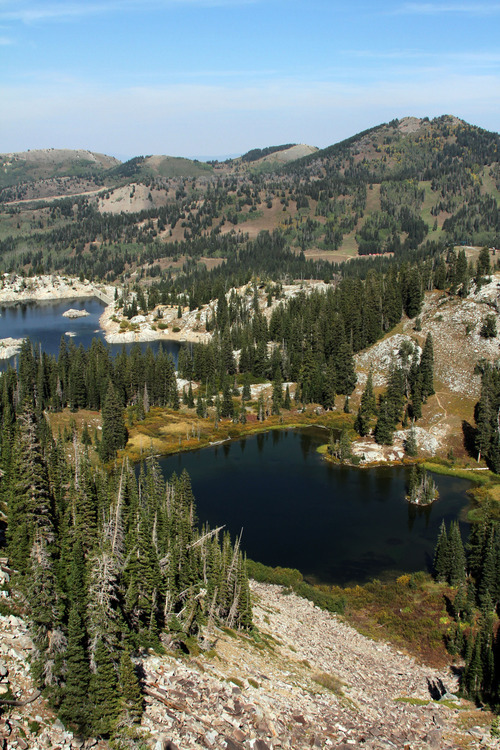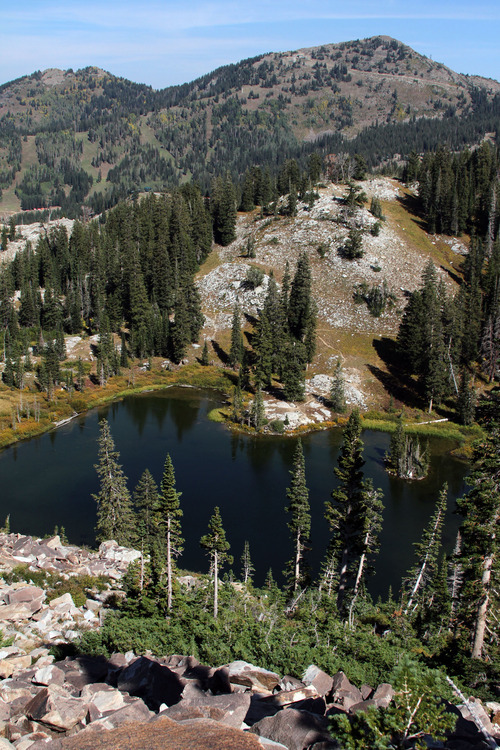This is an archived article that was published on sltrib.com in 2012, and information in the article may be outdated. It is provided only for personal research purposes and may not be reprinted.
Salt Lake City's ownership of land around and under reservoirs in upper Big Cottonwood Canyon is being challenged in a 3rd District Court lawsuit.
In the suit filed Sept. 12, Great Western Mining Co. is asserting it owns the surface rights to four parcels of land near Lake Mary, including some property beneath most of Martha Lake, a smaller body of water just uphill from Mary.
Citing century-old mining claims, the company has been pressing this thesis for the past year, hoping to persuade the city to enter into an exchange whereby Great Western Mining would relinquish its ownership claim in return for unspecified concessions by the city elsewhere in the Wasatch Mountains.
City officials adamantly reject Great Western Mining's premise, contending Salt Lake City has held title to the parcels' surface rights since 1908 and that the company's subsurface mineral rights do not provide grounds for an attempted land grab.
"They're up in the night," Jeff Niermeyer, director of Salt Lake City's Department of Public Utilities, said of Great Western Mining's suit. "We're more than satisfied with our ownership position. We will defend our water rights and property rights as needed."
While the arcane mining-claim case involves issues of watershed protection and private property rights, it also could impact public access to long-popular hiking trails from Brighton Resort to Dog, Mary and Catherine lakes.
Significant sections of those trails pass through the disputed parcels. So if Judge Paul Maughan rules in Great Western Mining's favor, it is possible the company could post signs forbidding hikers from trespassing on its private property.
Will McCarvill, conservation director of the Wasatch Mountain Club, which has had a lodge on U.S. Forest Service land adjacent to Brighton Resort since 1929, said he has known of the simmering dispute for months and will pay close attention to the case.
"It's one of those things I've not lost any sleep over because I'm blissfully ignorant about where it's going to spin out," he said. "I have no concept of the validity of the [company's] case, given the complexity of the history up there."
But, McCarvill added, "If the city were to prevail, certainly access to those trails that are extremely popular among [Wasatch Mountain Club] members and other people would continue as usual. If it goes the other way, however, there would have to be an effort made to chat with the owners and see if they will permit access."
Preston Richards, a Salt Lake City anesthesiologist and one of Great Western Mining's owners, said the company — which has no active mining operations and nothing contemplated — is not interested in preventing public use of the trails.
"We're looking to a possible swap of this land for land outside of this heavily used area. We feel like it would be a much better situation if we could transfer our land ownership through some sort of swap or sale," he said. "If this area is popular with the public, we ought to get our value out of it."
Great Western Mining's claims date to 1907 when a company called Mountain Lake Mining Co. filed mining-claim patent requests with the federal General Land Office for the four parcels, known as the Ida May, Carnegie, R.A.B. and Martha. At that time, Salt Lake City resisted the patent applications, seeking to secure reservoir easements around seven small lakes at the top of the canyon.
There is no dispute that on Dec. 12, 1908, the General Land Office granted Mountain Lake Mining Co. the mineral rights to those four parcels. Or that the company's board had, three months earlier, approved a resolution saying title to the surface lands would be transferred to Salt Lake City.
Beyond that, perspectives differ.
Richards and his partners — Kevin Tolton and Daniel Christensen, both of Bountiful, and Bruce Mannes of Mesa, Ariz. — contend that the words of the resolution notwithstanding, there is no legitimate evidence the deed to those lands ever was handed over to the city.
Over the years, they maintain, the property and mineral rights were transferred to several new owners, becoming the possession of Great Western Mining in 2007. To support the company's ownership claim to the land, their lawsuit cited four instances over the past 20 years in which Great Western Mining and its predecessors received tax notices on the four parcels.
"There are a lot of issues up the canyons, issues of land usage and water rights," Richards said. "We're trying to figure out a way to resolve one of these issues that is satisfactory to those who truly own the land."
To Niermeyer, there is no doubt that Salt Lake City truly owns the land.
He said the city has a legitimate deed to the surface estate that was filed in the Salt Lake County Book of Mining Deeds on Jan. 28, 1909. Then, five years later, a court decision known as the Morse Decree confirmed the city's title to all of the reservoirs and the water they hold in upper Big Cottonwood Canyon."
"We've hired outside legal counsel [Mabey Wright & James of Salt Lake City] and are more than comfortable in our position," Niermeyer said. "They're trying to pull cloth together from threads. We're not going to be intimidated by it. … If we're wrong, the courts will tell us. But I don't think we're wrong."
Twitter: @sltribmikeg —
Ownership fight
Great Western Mining Co. technically filed a "quiet title action" to four parcels of land above Brighton Resort in Big Cottonwood Canyon, seeking to establish ownership to property and to "quiet" challenges to that claim.
Salt Lake City contends the company's lawsuit is slandering its century-old ownership of the land and has threatened to file a quiet title counterclaim and to seek attorneys' fees.







